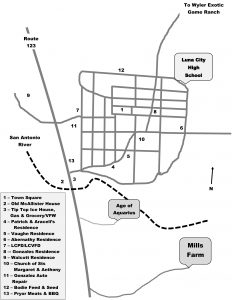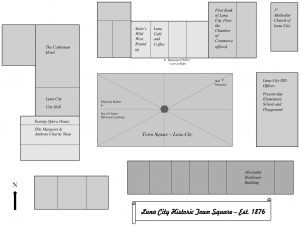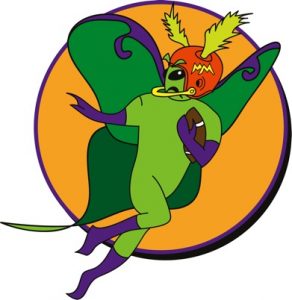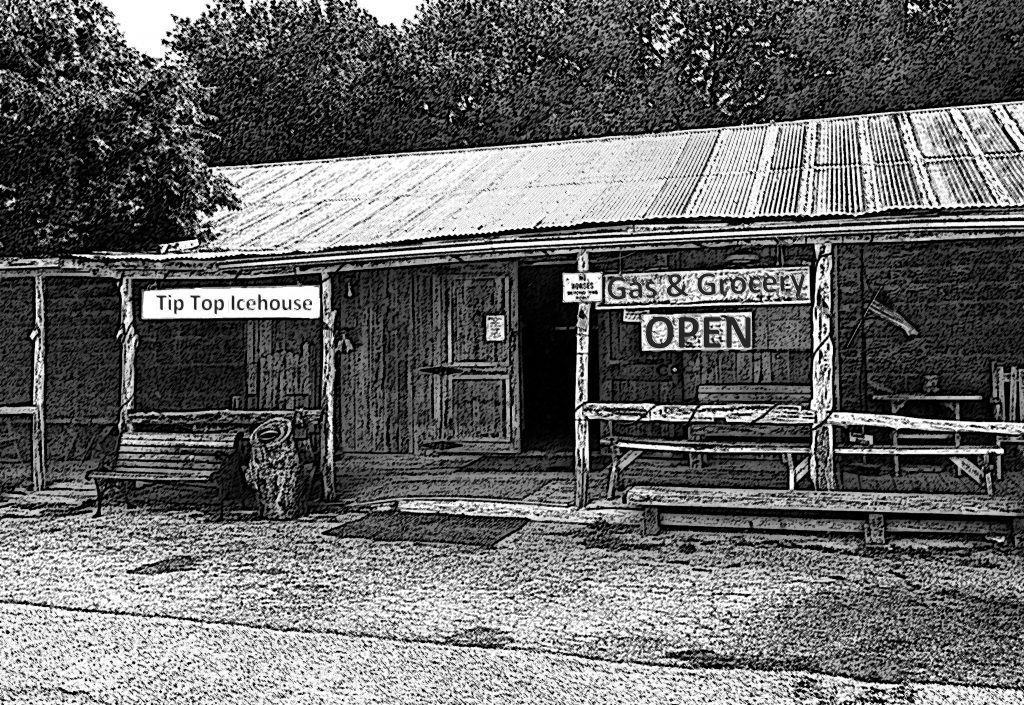Luna City is an incorporated township, located in Karnes County, Texas, at approximately 28°57′29″N 97°53′50″W, a point where Texas Rte 123 crosses the San Antonio River. The population of Luna City and environs in the 2010 Census was 2,453. The nearest large town is Karnesville, the county seat, approximately ten miles south of Luna City. Those residents of Luna City not employed in their own small businesses commute to Karnesville for work, or to nearby enterprises such as the entertainment/spa/commercial venue of Mills Farm, the Lazy W exotic game ranch, or in various oil-production ventures associated with the Eagle Ford shale oil formation. Notable people from Luna City include the prima ballerina Johanna Gonzales Garcia, international financier Collin Wyler, noted historian Douglas McAllister, Korean War jet-fighter ace Hernando “Nando” Gonzalez, and the legendary bootlegger Charles “Old Charley” Mills.

The land on which Luna City was later established was part of a 1769 Spanish land grant of a league and a labor to one Don Diego Manuel Hernando Ruiz y Gonzalez (or Gonzales), who may have been already settled in the area at the time that his grant was recorded. It is a matter of undisputed archeological record that Don Diego, members of his family or in his employ were engaged in grazing cattle, goats and sheep in the area, as an adobe structure on the northern outskirts of Luna City was extensively excavated and studied in the late 1960s. The structure apparently served as a shelter for both animals and people. Evidence of regular camping and hunting by elements of the native Tonkawa people at a fairly early date was also found in later excavations in the area. The first recorded permanent dwelling in the area was built in 1857 adjacent to an easily-forded stretch of the San Antonio River, by Herman Borgfeld, an immigrant stonemason from Bohemia, who ran a small general store, tavern and inn catering to travelers between San Antonio and the coast.
In 1867, a large portion of the tract originally part of the Gonzales or Gonzalez grant were purchased by Herbert Kling Wyler, formerly a captain in the Confederate Army, assigned during the hostilities to various garrisons west of the Mississippi and in Texas. Captain Wyler had been involved in various capacities with operations to move Confederate cotton to Brownsville and thence over the border to the Mexican port of Baghdad, from where it was shipped to Europe. He emerged from his wartime service with sufficient wherewithal to purchase outright what is presently the Lazy W Ranch, still run by his grandson, Dr. Stephen Wyler. Captain Wyler caused to be built a palatial residence, modeled after the magnificent Greek Revival-style mansion of Windsor, at Port Gibson, Mississippi, a mansion distinguished by a series of ornate columns all around the perimeter of the structure which extended from the main floor through two stories to the roofline and supported a wide veranda on the main floor, and wrap-around galleries on the second. It is thought that the local economy revived to a not inconsiderable degree, as construction of the house itself employed hundreds of local workers at a time and in a place where money was scarce. (The ranch residence and gardens are open to the public once yearly, for the term of a week in mid-September, as part of the observances of Founders’ Day, although application for private tour may be made through the website for the Wyler Game Ranch.)

Around 1884, or 1885, having made another considerable fortune in trailing herds of cattle north to Kansas, Captain Wyler became intensely interested in the possibility of establishing a town on his property, since the proposed town-site lay along a possible route proposed for the as-then-unbuilt San Antonio & Aransas Pass Railway. Along with Don Antonio Gonzalez, presumed descendent of Don Diego Manuel Hernando Ruiz y Gonzalez (or Gonzales) and the second largest landowner in the district, Captain Wyler formed a corporation to attract investors and businessmen willing to settle in a new town. Captain Wyler brought in as a partner in the project, an ambitious surveyor and engineer who dabbled in architecture, Arthur Wells ‘A.W.’ McAllister, to not only survey the site and create the city plat, but to design various public buildings, including a suitably impressive courthouse. It was confidently expected that Luna City, as Captain Wyler dubbed his project, would become the county seat. Arthur Wells McAllister in turn was so confident of success and committed to the project that he moved his family to the site, after purchasing, expanding and renovating the original Borgfeld stone house. (The house still stands amid spacious and well-maintained gardens along Rte. 123, and is lived in by his descendants.)
Alas for Captain Wyler’s ambitious plans; they were undone by love – specifically that of his daughter, Myra Elizabeth “Bessie” Wyler. Having married relatively late in life, his progeny numbered only three; two sons and Myra Elizabeth, the youngest. He doted upon them to a considerable degree, and especially on Myra Elizabeth – beautiful, indulged and impetuous. On returning from a year in a finishing school in New Orleans, which the Captain and his wife had hoped would curb Bessie’s naturally youthful high spirits, the young woman fell hopelessly in love with one Edward Standifor, some ten years her senior and employed as a locomotive engineer on the GH & SA Railway. Bessie Wyler eloped with Edward Standifor; they were married by a Justice of the Peace in Fort Worth and settled down to a life of respectable tranquility – but Captain Wyler’s fury knew no bounds. He not only disowned his daughter, but declared that his enmity against the railway – all it’s works, ways, establishments and personnel – was unremitting. The railway was, he declared in an impassioned statement to the San Antonio Express News, an open invitation to the establishment of vice and debauchery of every kind, a threat to the virtue of susceptible young women and girls everywhere … and he vehemently withdrew any support previously rendered to the establishment of a route for the San Antonio & Aransas Pass Railway which led through his property. From surviving correspondence, it appears that A. W. McAllister blithely assumed that this was an attempt by Captain Wyler to pressure the builders of the SA & AP into offering a higher price for the right-of-way through his property. A.W. had a basis for this belief, as Captain Wyler had a long-established reputation for driving a hard bargain, using every possible means at his disposal – including treachery and personal tragedy, as they served his immediate purpose.

Alas for the future of Luna City as a station on the SA & AP – Captain Wyler was completely in earnest. The managers of the proposed railway line shifted the proposed route to run through Karnesville – and all the investors in the Luna City project were left high and dry, including A.W. McAllister, who had sunk all of his own funds into the project and therefore had to make the best of it. Fittingly enough, he did prosper in a mild way – although not to the degree that he would have, if the whole project had come about as originally projected. Still – he was respected and honored, as the decades wore on; the man who originated the vision of Luna City, and designed nearly every one of its surviving public buildings. Architectural historians and aficionados for this kind of thing laud Luna City as a peerless and harmonic jewel of minor late Victorian and Beaux-Arts city planning.
As for Bessie Wyler Standifor, she and her husband lived to a ripe and happy old age, parents of a large and prosperous family. In the early years of the 20th century, she and whoever of her children wanted to accompany her were frequent guests of honor at Founders Day observances. It is noted, however, that her father throughout the remainder of his life eschewed railway travel, choosing to travel in a horse and buggy until the development of other means of transportation. Captain Wyler was the first recorded owner of an automobile in Karnes County in 1901 – a Columbia Electric Runabout – and the first to die in an automobile accident five years later, when – at the wheel of it and against the advice of his chauffeur – he collided with another motorized vehicle on what would become Rte. 123. There is a historical marker alongside the roadway where this occurred. Folk memory has it that the driver of the other vehicle was none other than Charley Mills, with a load of illicit whiskey.


Recent Comments